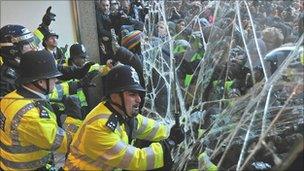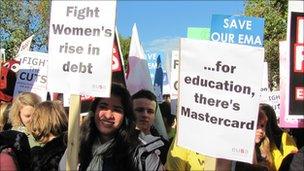How the student fees protest turned violent
- Published

Police were outnumbered as demonstrators smashed windows to go past them
The siege of the Millbank office complex, ending with the smashing of the windows and the occupation of the building, was a violent break-away from what had until then been a noisy but good-natured march against raising tuition fees.
There had been a huge turnout for the demonstration - much more than the 20,000 that had been expected.
Student leaders later said there could have been 50,000 crowded on to the streets of Westminster.
There were strong feelings on the march - with much vitriol targeted towards Prime Minister David Cameron and Deputy Prime Minister Nick Clegg.
Banners and pictures particularly accused Mr Clegg, often in unambiguous terms, of betraying students.
There were students, articulate and animated, ready to tell anyone who would listen that they were enraged by the raising of fees.
And they returned again and again to their anger at how the Liberal Democrats appeared to be about to break their promise to students to vote against a fee increase.
Missiles thrown
But this only flared into violence when a small group left the main protest, carrying what appeared to be an effigy, and gathered in the area in front of the 30 Millbank office building.

Most of the students on the rally had been peaceful and good-natured
A crowd followed them, flooding into this enclosed area, cheering as the effigy was burned.
Placards were then thrown on to the fire, throwing smoke across the chanting crowd. Drums were banged, flares were set off and the shouts and slogans became more aggressive.
As more people crowded around the building, including some masked and hooded demonstrators, the mood changed. It became clear that there was going to be an attempt by some demonstrators to force their way inside.
Missiles began to fly towards the large plate glass windows across the front of the building, which was only protected by a thin line of police, standing with metal truncheons raised.
They were guarding the entrance against what had swiftly become a siege, their backs against a glass wall.
Outnumbered and overwhelmed, this line of policemen was slowly but relentlessly hemmed against the front of the building, missiles raining down on them.
Overrun
As protesters surged, a succession of windows were smashed and demonstrators flooded into the entrance.
Security guards scattered and the handful of police inside were completely overrun. As the police tried to stop them, protesters clicked a battery of cameras in their faces.
A few yards away, in surreal calm, guests carried on eating in the adjacent Pizza Express.
It was a bizarre sight inside the building.
Demonstrators wearing police hats danced on tables. A protester ripped a security camera from the ceiling and danced in triumph. Slogans were spray-painted on walls. Smoke from the bonfire blew across the crowd.
The protesters smashed everything inside with relentless ferocity. Office chairs were used as weapons to destroy what was left of the glass.
The level of anger and the swiftness of the violence seemed to have caught everyone by surprise. It had lurched without warning from a well-organised, up-beat publicity event to something much more destructive.
Who were the rioters? It wasn't obvious from close-up.
National Union of Students president Aaron Porter was aghast at what had happened, turning a huge turnout into a huge mess of shattered glass.
He looked appalled as he talked about how the protest had been "hijacked", taking it away from the planned route.
Panicky stampedes
There were claims that the damage had been caused by a hard-core of violent protest junkies who had deliberately come for trouble.
But it had been an unlikely collection of people crowding around the smashed glass.
There were young middle class students, perhaps on their first march, alongside anarchists with masked faces and gangs of what seemed like even younger teenagers, swept along by events.
Office workers in suits stood watching bemused from the sidelines. A youngster in a tweed jacket walked through the wreckage of the building's entrance.
As riot police gathered, students argued about what had happened.
Most seemed startled by the events, some looked scared, others excited. There were panicky stampedes as they thought the police were going to seize back the building.
One group had made a placard saying: "Break the cuts, not the windows."
Everyone seemed to be taking photographs of each other. It was a riot in which everyone seemed to be armed with a camera and mobile phone.
This was one revolution that was going to be televised.